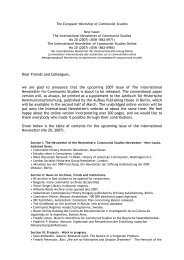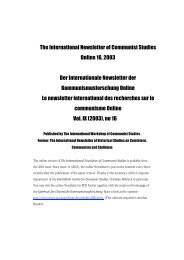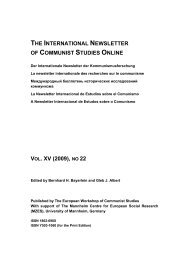Vol. XIII (2007), no 20 - The International Newsletter of Communist ...
Vol. XIII (2007), no 20 - The International Newsletter of Communist ...
Vol. XIII (2007), no 20 - The International Newsletter of Communist ...
Sie wollen auch ein ePaper? Erhöhen Sie die Reichweite Ihrer Titel.
YUMPU macht aus Druck-PDFs automatisch weboptimierte ePaper, die Google liebt.
<strong>The</strong> <strong>International</strong> Newletter <strong>of</strong> <strong>Communist</strong> Studies Online <strong>XIII</strong> (<strong><strong>20</strong>07</strong>), <strong>no</strong> <strong>20</strong> 107<br />
initiative taken by Münzenberg himself, and through the network channels <strong>of</strong> his main<br />
organisational "pet object", the <strong>International</strong>e Arbeiterhilfe (IAH, in English: Workers’<br />
<strong>International</strong> Relief, WIR). At the beginning, this was a relief organization founded after a<br />
discussion Lenin and Münzenberg had in August 1921 in Moscow, aiming to materially and<br />
financially counteract the starving in Soviet Russia. As the effects <strong>of</strong> the New Eco<strong>no</strong>mic Policy<br />
(NEP) had created positive results in the Soviet society, the need for an international relief<br />
organization gradually lost its value. Nevertheless, IAH had managed during its first years <strong>of</strong><br />
existence to gather a large international crowd <strong>of</strong> supporters, both financially and morally, to<br />
defend the Soviet political system. <strong>The</strong>refore the transition from a purely operative relief<br />
organization to a multilayered relief and propaganda machine became real after 1923. 167<br />
Cut and Paste – <strong>The</strong> Limited Historicisation on the LAI & Approaching the Archives<br />
<strong>The</strong> historiography, or rather historicisation, <strong>of</strong> the Comintern controlled front organizations<br />
like the LAI is rather scarce and limited. Research has so far been insignificant, and only<br />
cursory investigations have been done. Historian Sean McMeekin in his biography <strong>The</strong> Red<br />
Millionaire (<strong>20</strong>03) on Münzenberg touched the subject briefly, concluding incorrectly that the<br />
League ceased to exist in 1929. 168 Stephen Koch stated in Double Lives (1995) that LAI was<br />
only an “instrument for propaganda, sabotage, and espionage”. Partly correct (on the point<br />
<strong>of</strong> propaganda), partly incorrect on other points (empirical evidence does <strong>no</strong>t verify Koch’s<br />
view on sabotage and espionage), his book is a rather sensationalist piece on Münzenberg’s<br />
life and death career in the Comintern. 169 <strong>The</strong> only valuable interpretation <strong>of</strong> LAI put on<br />
paper so far, has been accomplished by former East German historian Mustafa Haikal. Even<br />
though Haikal only was able to provide us with a chro<strong>no</strong>logical analysis on the organization in<br />
his article, “Willi Münzenberg und die Liga gegen Imperialismus und für nationale<br />
Unabhängigkeit” (1995), still he had access to files <strong>of</strong> the Comintern Archives in Moscow. 170<br />
<strong>The</strong> Comintern archive acts as the empirical basis (as in the case <strong>of</strong> my research project) for<br />
any research trying to unveil the functions and operations <strong>of</strong> front organizations like the LAI.<br />
But still, the material has to be complemented with files found in other archives. 171 So to<br />
Resolutionen, „Organisationsresolution“, published by League against Imperialism, Berlin, 1927, pp. 37-<br />
38.<br />
167 See for example Willi Münzenberg, Fünf Jahre Arbeiterhilfe (Berlin, 1926), or Willi Münzenberg,<br />
Solidarität (Berlin, 1931)<br />
168 Sean McMeekin, <strong>The</strong> Red Millionaire – A Political Biography <strong>of</strong> Willi Münzenberg. Moscow’s Secret<br />
Propaganda Tsar in the West, Yale University Press, <strong>20</strong>03, p.<strong>20</strong>8. See also Sean McMeekin’s “Willi<br />
Münzenberg – <strong>The</strong> Comintern’s Greatest Con Man”, in Jahrbuch für Historische Kommunismusforschung,<br />
Mannheim, <strong>20</strong>02, pp. 418-419.<br />
169 Stephen Koch, Double Lives – Stalin, Willi Münzenberg and the Seduction <strong>of</strong> the Intellectuals,<br />
London, 1995, p. 38, 64<br />
170 Mustafa Haikal, “Willi Münzenberg und die Liga gegen Imperialismus und für nationale<br />
Unabhängigkeit“, in Tania Schlie (ed.), Willi Münzenberg: ein deutscher Kommunist im Spannungsfeld<br />
zwischen Stalinismus und Antifaschismus, Frankfurt am Main, 1995, pp. 141-154. Haikal was also a<br />
contributor to the “celebratory” anthology on LAI, published by the Karl Marx University in Leipzig<br />
(1987), Die Liga gegen Imperialismus und für nationale Unabhängigkeit 1927-1937, published to<br />
commemorate the 60 th anniversary <strong>of</strong> the League.<br />
171 Archival holdings that have been utilized during the research process, apart from the RGASPI in<br />
Moscow, are the Bundesarchiv / SAPMO (BArch) in Berlin; the National Archives in London (Kew); the<br />
National Archive in Stockholm; the Stockholm City Archive (SCA); the SÄPO archive in Sweden (Security














